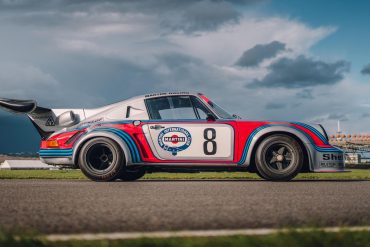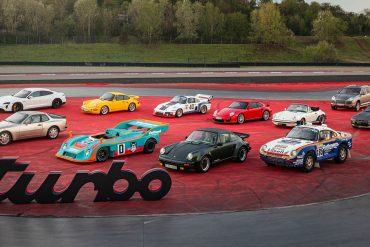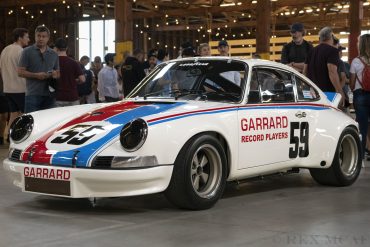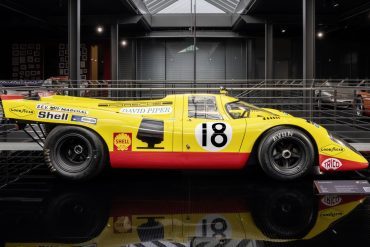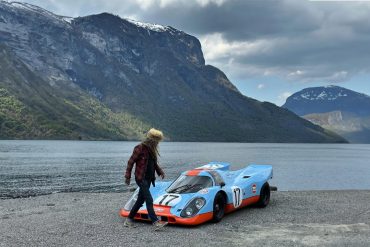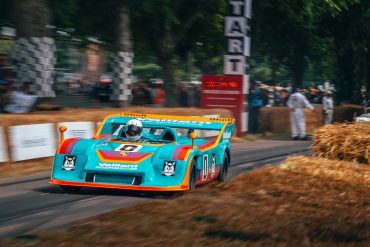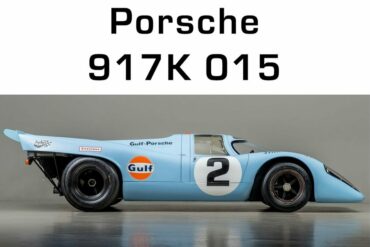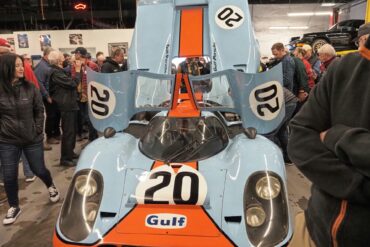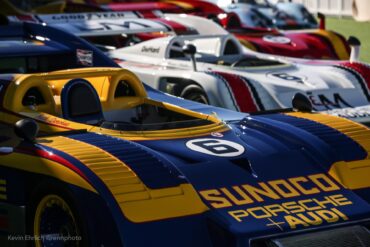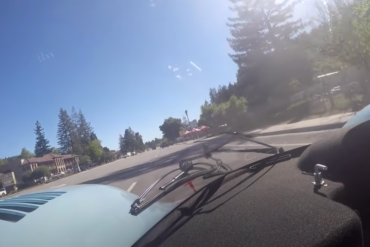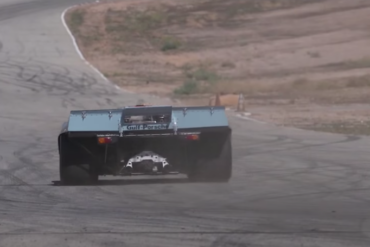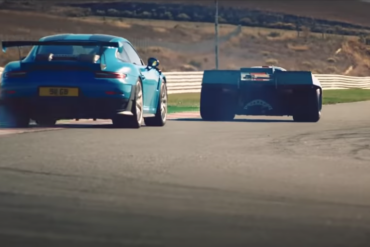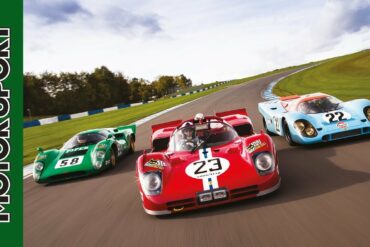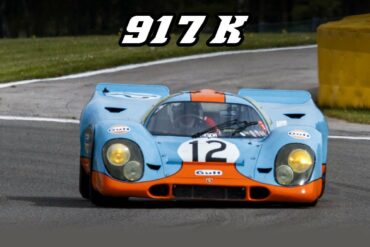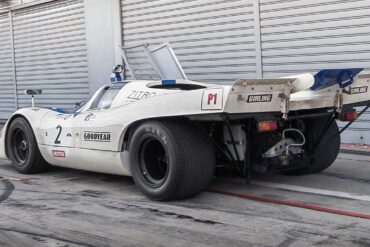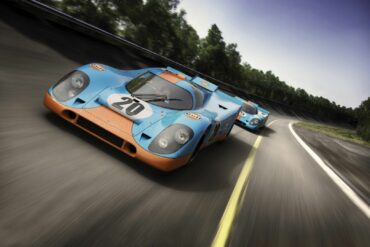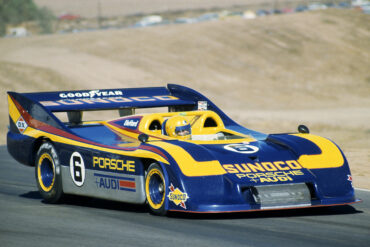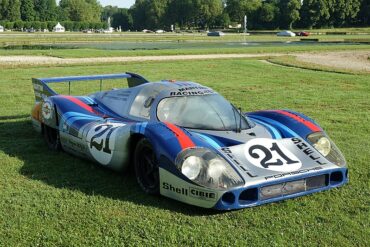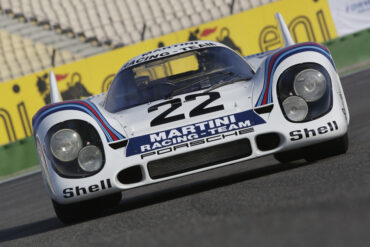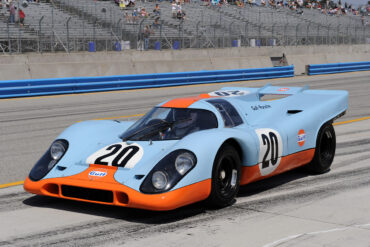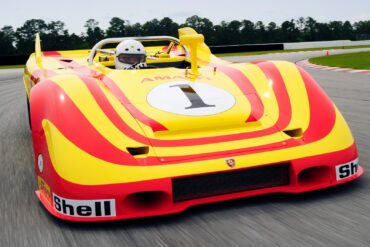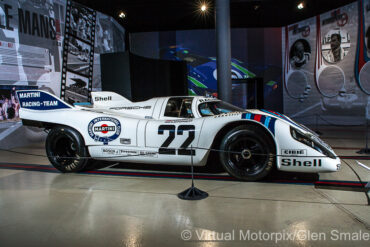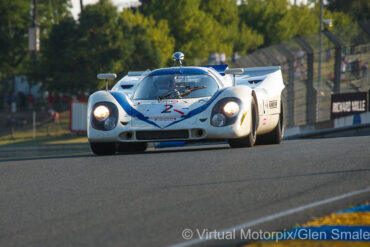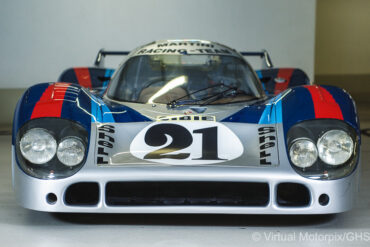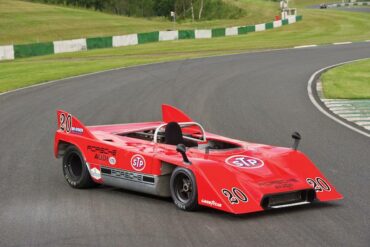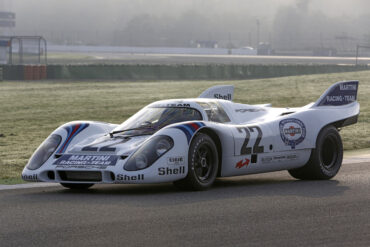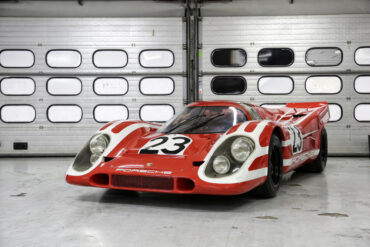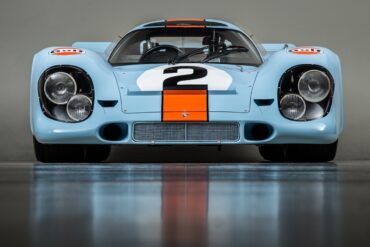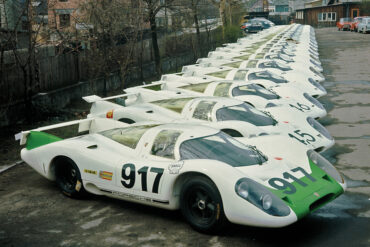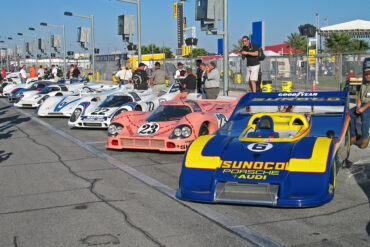World famous icon to be auctioned in 2025 One of the most recognizable race cars of all time is coming...
Porsche 917
Porsche 908, 909 and 917 racing cars were the brainchilds of engineering genius Ferdinand Piëch, the grandchild of Ferdinand Porsche and nephew of Ferry Porsche. The 917 was the only Porsche model produced with the 12-cylinder engine and experimentally even with the 16-cylinder. When the new rules for the International Championship for Sports Cars were made public at the end of 1967, the team in Stuttgart-Zuffenhausen decided to build a new race car for the under-five-liter class. As the successor to the successful 907 and 908 types, the 917 got an air-cooled twelve-cylinder engine. Powered by the Type 912 flat-12 engine of 4.5, 4.9, or 5 litres, the 917/30 Can-Am variant was capable of a 0-62 mph (100 km/h) time of 2.3 seconds, 0–124 mph (200 km/h) in 5.3 seconds. The long tail Langheck version had a maximum measured top speed of 362 km/h (225 mph). It was dominant, scary and probably the most insane racecar ever built. See all our Porsche 917 Research.
All
Chassis #019 Campaigned by the Martini Racing Team in 1971, chassis #019 has been preserved in the same unrestored condition...
‘It feels like a bathtub with a bomb stuck to the back of it!’ Those were the words of a...
The night before… One night in 1999, under cover of darkness, an entire terminal building was lifted onto flatbed trucks...
Incredibly successful in Le Mans Porsche was incredibly successful with the 917 in Le Mans and in the World Championship...
With the 911 GT3 RS Tribute to Jo Siffert, Porsche is paying tribute to the late Swiss racing driver while...
Le Mans, the movie This Porsche 917K was immortalized as the race winner in Steve McQueen’s 1971 film Le Mans,...
A visit to Porsche at the Retro Classics in Stuttgart is always a journey through time. This year, the sports...
The legendary Porsche 917 debuted at the Geneva Motor Show on March 12, 1969. Hans Mezger, renowned for Porsche’s flat-six...
The undisputed King The Porsche 917, conceived in the late 1960s, emerged from Porsche’s strategic intent to conquer the World...
Fifteen years ago, the Porsche Museum opened its doors to visitors from all over the world for the first time....
From the creators of Luftgekühlt comes the largest single-brand automotive experience to hit Southern California. It embarks on a fresh...
Background The Porsche 917, unveiled in 1969, stands as a testament to Porsche’s commitment to innovation and their quest to...
A genuine display of vehicle craftsmanship and ingenuity, The Nationales Auto Museum: The Loh Collection, showcases an assemblage of approximately...
The Can-Am Porsche 917 The Can-Am Race Series, held from 1966 to 1974, helped propel professional sports car racing to...
Renowned designer and Porsche aficionado Magnus Walker got the opportunity to get behind the wheel of a Porsche 917K replica...
After claiming two Le Mans victories with the iconic 917 Kurzheck, Porsche’s Weissach engineers converted it into a Group 7...
The ultimate expression of CanAm’s unique sky’s-the-limit approach to technical regulations, this 1200bhp twin-turbo monster was a sensation, rubbing salt...
75th Anniversary The Stuttgart marque took center stage at this year’s Festival of Speed to pay tribute to the 75th...
Despite being 50 years old, the formidable Porsche 917/30 still boasts a power-to-weight ratio that rivals that of a modern...
Watch as Bruce Canepa gets behind the wheel of a 1969 Porsche 917K with chassis number 917-015 around the famous...
With the aerodynamic instability of the 917 in the 1969, two separate configurations were used in 1970. These were the...
Have you seen a Porsche 917 in action outside of Le Mans? If not, you’re in for a treat as...
Images by: Virtual Motorpix/Glen Smale and Corporate Archives Porsche AG The Porsche 917 was the culmination of a line of...
Key Moments from the Porsche Club of America Event Below: Tech ED Event Organizer John Mueller introduces the program and...
The 917 Kurzheck Coupé (917K) first appeared in 1970 and contributed more to the Porsche 917 story than any other variant. It...
The loophole Porsche racecar Ferrari couldn’t touch! The Porsche 917 was the brainchild of engineering genius Ferdinand Piëch, the grandchild...
The Porsche 917 story is among the most significant chapters of the marque’s history. More than five decades after the...
Drivers View Porsche 917K On Track A visor-cam in a $20 million Porsche 917K? Absolutely. Let driver Bruce Canepa and...
Porsche 917K Onboard Video filmed during Rennsport Reunion IV, in 2011 at Laguna Seca Raceway in Monterey, California. Chassis 016...
Driving A LeMans Race Car To Dinner! Whilst in Kansas, I got the amazing opportunity to jump behind the wheel...
Bruce Canepa Street Driving the 1969 Porsche 917 Come along for the ride in the 1969 Porsche 917 driven by...
Epic Porsche 917 On-Track Shakedown Hosted by Porsche Cars North America, Rennsport Reunion V once again brings together an extraordinary...
Porsche 917 vs Porsche 911 GT2RS James May joins the legendary Dickie Atwood to race the Porsche 917 against Neel...
Triple test: Porsche 917, Ferrari 512S and Lola T70 Porsche 917, Ferrari 512, Lola T70 – perhaps as great a...
Porsche 917K Racing at Spa A works car, this 917 was entered at Le Mans in 1969 for Vic Elford...
Porsche 917K Track Video This is a video of a 1969 Porsche 917 (chassis 025) racing at Monza Circuit during...
Monterey 2021—How to Start the 1970 Porsche 917 K How do you start a Porsche race car? It might be...
Porsche 917K racing at high speeds! (brutal flat-12 sound) The 917 Kurzheck is very rare and very expensive. However, on...
Porsche 917K Goodness – Turn Up The Volume...
The Porsche 917 – What They Said We found some great interviews from back in the day on what drivers...
Some great work by one of our colleagues who managed to put together the chassis numbers for all the Porsche...
In 1996 the 30 years of the Canadian – American Challenge Cup series were celebrated, better known as CanAm and which only...
The Engines Engine Type 912 – 12 Cylinders The Porsche House made it the norm since 1967 to participate in the tests for...
A total of 30 drivers managed to win races during the four-year period between 1968 and 1971. Here’s the breakdown:...
A Brief History In mid-1967 the International Automobile Federation (FIA) announced that it had decided to modify the regulations pertaining...
Porsche 917/30 Specifications type Racing Car built at Germany production 6 units engine Air Cooled, Magnesium/Aluminum Alloy Flat-12 position Mid...
1972 Porsche 917/10 Specifications type Racing Car production years 1971 – 1972 built at Germany engineers Hans Mezger, Helmut Flegl...
1971 Porsche 917 Langheck Specifications 4.9 L Flat 12 Engine Spec type Racing Car built at Germany engine Air Cooled...
1971 Porsche 917 Langheck Pictures...
1970 Porsche 917 Langheck Specifications 4.5 L Flat 12 Engine Spec type Racing Car built at Germany engine Air Cooled...
1971 Porsche 917 K Pictures Visually, the “shark fins” on the tail look awesome, but they also gave the Porsche...
1971 Porsche 917 Kurzheck Specifications type Series Production Car production years 1970 – 1971 released at 1969 Geneva Motorshow built...
1970 Porsche 917 Kurzheck Specifications type Series Production Car production years 1970 – 1971 released at 1969 Geneva Motorshow built at...
Porsche 917 ‘Interserie Spyder’ Specifications built at German body stylist Gerhard Schroeder engineers Helmut Flegl, Paul Hensler production 3 units...
Held in the grounds of Hedingham Castle, Classics at the Castle is a very special Porsche car show held annually....
ACO Museum, Le Mans 16 September 2020: As it was the 50th anniversary of Porsche’s first win at Le Mans,...
In our series of looking back at the racing icons of history this month, in preparation of global motorsports returning...
50 years of the Porsche 917 Anniversary The most famous racing car of all time made its debut at the...
One of Only Two in the World...
Porsche 917 Full Demo – 77th Members’ Meeting ...
Simeone Foundation Museum – 1970 Porsche 917-043 While diplomats and cartographers may technically show the roads around Le Mans as...
1973 Vasek Polak Porsche 917/10-018 Cam-Am Spyder driven by Jody Scheckter Jody Scheckter was born in East London on the...
#21 Martini Porsche 917 LH (chassis #042) was driven by Gerard Larrousse and Vic Elford in the 1971 Le Mans...
Memories of Porsche 917-021 at Le Mans 24H and driving at Spa Francorchamps. This video footage was shot to accompany...
The video shows the Porsche 917 in action driven by Derek Bell. It also contains some period footage of an...
1970 Gulf Racing Porsche 917 K (chassis #917-024) If you would like to own a piece of motor racing history,...
1970 Porsche 917/10 prototype chassis #917/10-001 as offered for sale on 8 February 2017 Mention the name Porsche and motor...
1971 Porsche 917 16-Cylinder Prototype Pictures & Gallery...
1971 – 1972 Porsche 917/10 Pictures...
1973 – 1974 Porsche 917/30 Spyder Pictures...
1970 Porsche 917 ‘Interserie Spyder’ Pictures...
The 917/20 Turbo is a confusing car - its chassis number reads 917/30-001, but it is not the real 917/30. In its first race it was called as the 917/10 Turbo. Sharp eye can detect that it was not just the 917/10 Turbo, but an evolution of it. At the same time it was not the evolution of the 1971 Le Mans 917/20. Still, the car should not be called as the 917/30 to distinct it from the "real" 917/30 Can-Am racers and in 1974 it was decided to call it as the 917/20 Turbo.
The final evolution of the 917 was created after Ferdinand Piëch had left the Porsche company in 1972. Two complete 917/30 Can-Am cars with 2500 mm (98.4") wheelbase were made for Roger Penske Enterprises racing team. They were chassis 917/30-002 and 003. The 001 car was not a real 917/30 and was raced in Europe at the Interserie. The Can-Am 917/30 had a 5.4-litre flat 12-cylinder twin-turbo engine which produced so much power that nobody really knew how much.
The first turbo-Porsche, Can-Am winner 1972, Interserie winner 1972, 1973. The first ever publically seen turbocharged Porsche was the 917/10 Turbo with chassis number 917/10-011. It was entered for the June 11, 1972 Can-Am Mosport race. Mark Donohue was fastest in the qualification with it, but scored second in the 80 laps race after the 8.1-litre McLaren. The Porsche Turbo era had begun. Eight 917/10 were racing in 1972 in Can-Am and in Interserie.
The 1972 917/10 was similar in its design to the 908/03, but, of course, had the 12-cylinder engine instead of the 3-litre flat-8. The 917/10-72 was first seen at the Interserie Nürburgring race on April 3. It was the chassis 004 car of Leo Kinnunen and Keimola Racing Team AAW. Kinnunen scored 4th in the first race, but would win the championship by the end of the season. The second Interserie race was at Monza on May 1st and that race was won by chassis 917/10-002 and Willy Kauhsen.
Jo Siffert was the first to take the 917 to Can-Am championship. The car he used in 1969, was the 917 PA Spyder. Although he participated in one Can-Am race in 1970 with a 917 K, that season he skipped. He was back from mid-season 1971 and now with the 917/10. Only two 917/10 were created in 1971. The chassis 001 was used for testing and the 002 by Siffert. He took part in six races out of ten, managed podium finishes three times and scored 4th in the season, like in 1969.
An attempt to blend the best aerodynamic characteristics from both the short-tailed 917 K and long-tailed 917 LH led to the the 917/20, otherwise known as the Pink Pig. The car's combination of a long body, stubby face, and wide hips gave it a pig-like look, which inspired Porsche designer Anatole Lapine to give the car a pink paint job with butcher cut lines covering the exterior. It was hugely popular at the 1971 Le Mans race, and was the fastest in qualifying and nearly came in fifth place, before a brake failure caused it to crash before the finish line.
The “shark fins” on the tail gave the Porsche 917 KH 1971 greater directional stability and reduced wind resistance by 11 percent. In 1971 a veritable armada of six Porsche 917s started at Le Mans. The car with start number 22 was special. The white race car with the characteristic Martini stripes had the new “shark fins” on the tail that Porsche had first used in pretraining in April. This 917 was also the first Porsche with a magnesium tubular frame to be used in a race.
Like the 917 LH of 1969 and 1970, the 1971 version was also made for one race only - the 24 hours of Le Mans. The 917 LH-70 had already proved that the body was excellent for Le Mans, so the aerodynamical modifications for 1971 were mild. The front was modified and the rear wheels were covered. The 917 LH-70 that scored 2nd at the 1970 Le Mans 24H (chassis 917-043) was modified for the Le Mans 1971.
The 917 Kurzheck Coupé (917K) first appeared in 1970 and contributed more to the Porsche 917 story than any other variant. It was a high-down force version that featured a cut-off tail for increased downforce. This reduced the cars top speed, as much as 30 mph. Le Mans winner 1970, Interserie winner 1970 and Manufacturers' World Championship for Porsche in 1970.
With the aerodynamic instability of the 917 in the 1969, two separate configurations were used in 1970. These were the short-tail Kurzheck version and the less common Langheck or long-tail. Most of the 917's accolades were achieved by the 917 Kurzheck, leaving the Langheck a less popular, but ultimately just as potent contender.
By 1969, Porsche develops the 917 Spyder with a view to competing in the extremely popular North American racing series, the Canadian American Challenge Cup (Can-Am). Three units featuring 4.5-litre twelve-cylinder naturally aspirated engines are constructed in Zuffenhausen, and Jo Siffert takes one to the US to compete in the Can-Am races, ultimately placing fourth overall. The car becomes known as the 917 PA Spyder, with “PA” standing for “Porsche + Audi” as they are the two sales organisations in the US at the time.
Although the longtail 917 was introduced first, it was meant only for the Le Mans. This meant, the short tail 917 K ("Kurz" in German for short) was raced first. The only engine available in 1969 was the 4.5-litre flat 12. The factory team enters one 917 K also for the Nürburgring 1000 km race, where it scores 8th. The factory team would not enter 917 K for racing anymore in the season, only private teams will.
For the 1969 racing season an absolutely new Porsche 917 with 4.5-litre 12-cylinder engine was created. Ferdinand Piëch relied on the skilfulness of Hans Mezger, who was responsible for the overall construction of the vehicle and its engine. The aim was to create the fastest racing car ever. Short and long tail versions were developed, called as the 917 K ("Kurz" = short in German) and the 917 LH ("Langheck" = long tail). The first car was assembled in December 1968.
The Group 7 class in CanAm was virtually unlimited with regard to regulation, so Porsche was free to try many different avenues to source extra power. Two main themes were explored: the first was to go into uncharted territory and turbocharge engines with an exhaust-driven turbine. Eventually this was the chosen route, but it didn't reach fruition until a larger 16-cylinder engine was tried.
Porsche 917 Turns 40 Porsche launched the 917 40 years ago and it’s still their most important racecar to date. This...






